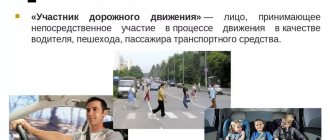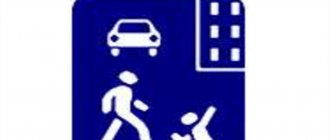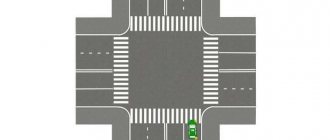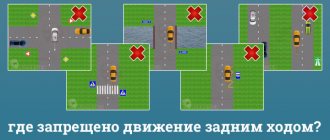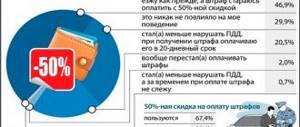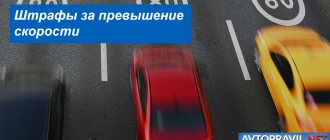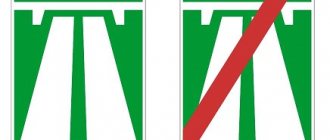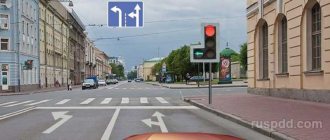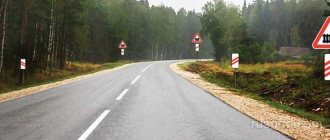Official interpretation for 2021
8.1. Before starting to move, change lanes, turn (U-turn) and stop, the driver is required to give signals with turn signals in the appropriate direction, and, if they are missing or faulty, with his hand. When performing a maneuver, there should be no danger to traffic or interference with other road users.
The signal for a left turn (turn) corresponds to the left arm extended to the side or the right arm extended to the side and bent at the elbow at a right angle upward. The right turn signal corresponds to the right arm extended to the side or the left arm extended to the side and bent at the elbow at a right angle upward. The brake signal is given by raising your left or right hand.
When is it allowed to travel on passing tram tracks?
The Rules do not allow occupying tram tracks without a reason.
There are no additional restrictions for left turns and U-turns, that is, these maneuvers can be performed on any section of the road where other prohibitions are not established by the Rules or signs.
Last modified
The last and only time amendments to clause 8.1 of the traffic rules were made by Government Decree No. 316 on May 10, 2010. The second sentence of the first paragraph has been changed:
| Before the change | After change |
| 8.1. Before starting to move, change lanes, turn (U-turn) and stop, the driver is required to give signals with turn signals in the appropriate direction, and, if they are missing or faulty, with his hand. In this case, the maneuver must be safe and not interfere with other road users. | 8.1. Before starting to move, change lanes, turn (U-turn) and stop, the driver is required to give signals with turn signals in the appropriate direction, and, if they are missing or faulty, with his hand. When performing a maneuver, there should be no danger to traffic or interference with other road users. |
Comments to clause 8.1 of the traffic rules
So, this point:
- regulates the rules for using turn signals during maneuvers,
- regulates that when performing maneuvers you must give way in general cases (if more specific traffic rules or signs do not establish an advantage).
Rules for using turn signals during simple maneuvers
Actually, everything here is quite simple - during certain maneuvers you need to turn on the following turn signals:
- when turning left - left,
- when turning right - right,
- when changing lanes - according to the direction of changing lanes,
- when starting to move from the side of the road or the edge of the road - according to the direction of movement: from the right edge - left,
- from the left edge (this is allowed on a one-way road or on a two-way road without a continuous one) - right,
When overtaking
Here, many drivers make the mistake of turning on and not turning off the left turn signal throughout the overtaking process.
Meanwhile, overtaking itself consists of 2 maneuvers: changing lanes to the left (oncoming lane), moving straight ahead, and then changing lanes to the right (passing) lane.
And in this case, according to paragraph 8.1 of the Rules, you should turn the direction indicators on and off 2 times:
- when changing lanes into oncoming traffic - left, then immediately after changing lanes it must be turned off, otherwise other road users will think that you are turning left from the road,
- when returning to your lane - right.
Let us also remind you that, according to paragraph 8.2 of the traffic rules, the turn signal must be turned on in advance, and turned off immediately after the end of the maneuver. Paragraph 8.1 of the traffic rules, in addition, prescribes not to interfere with overtaking (the driver of the blue car in the diagram above), but a more specific prohibition on this is contained in paragraphs 11.1 and 11.2 of the Rules.
On a roundabout
In this situation, everything is a little more complicated. According to the current traffic rules for 2021, the roundabout is an intersection (clause 13.11.1).
However, the circle itself is considered traffic on the road. Hence:
- when entering a roundabout, you make a right turn (paragraph 8.5 of the traffic rules) - you need to turn on the right turn signal,
- when driving around a roundabout, turn off the turn signal (and no left turn signals),
- when entering the roundabout, turn the right turn signal again.
Everything in these points looks logical, if not for one “but”. Traffic management at many roundabouts is often inconsistent and does not make it obvious that a right turn is being made. For example, here's an intersection:
Here the driver can mislead other road users if he turns on the right turn signal.
Remember also that you can enter the roundabout from any lane, but exit only from the right.
Chapter 8 Traffic Regulations. Start of movement, maneuvering
Paragraph 8 of the traffic rules is included in the theoretical part of the exam at a driving school and regulates the start of movement and maneuvering at intersections.
Clause 8.1 of the traffic rules Before starting to move, make a U-turn, turn or change lanes, or stop, the driver is required to give signals with turn signals and his hand to other road users.
In case of malfunction or absence of light indicators, give a warning using your hand. The latter applies to motorcycle and moped drivers. The maneuver should not become an obstacle or a source of danger for the movement of other vehicles, pedestrians or cyclists.
Hand signals for maneuvering
1, Turn left or turn - the left arm is extended to the side, or the right arm is also extended to the side and bent at the elbow upward at a right angle
2. The left arm is extended to the side and bent at the elbow upward at a right angle, or the right arm is extended to the side - such a hand signal given by the motorcyclist informs you that he is about to turn right .
3. One of the hands raised up - this hand signal given by the driver of a car informs you about braking .
Paragraph 8.2 of traffic rules When do you need to turn on your turn signals? The rules oblige the driver to give a turn signal using his hand or indicators until the maneuver is carried out .
- If the maneuver is successful, the signal must stop immediately to avoid misunderstandings.
- It is also prohibited to mislead other road users by displaying signs.
- The maneuver signal does not give the driver any advantage on the road and does not exempt the driver from taking minimum precautions.
Clause 8.3 of the traffic rules When leaving the adjacent territory (parking or parking inside the yard), the driver of the vehicle is obliged to give way to all traffic participants moving along this section of the road, whether drivers or pedestrians.
When leaving the road lane, give way to those vehicles and pedestrians whose direction of travel you need to cross.
Clause 8.4 of the Russian Federation Rules for changing lanes.
When changing lanes, the car owner is obliged to give way to all vehicles that are moving in the same direction and do not intend to change it. If several vehicles are changing lanes at the same time (mutual lane changing), the driver (on the left) must give way to the driver who is on his right.
Clause 8.5 of the Russian Federation Traffic Regulations Before making turns in any direction or making a U-turn, the driver should move his vehicle to the outer lane in the direction of travel in advance.
Rebuilding
Traffic rules 8.5 Changing lanes to the outer lane
Roundabout Circulation
The exception is a situation in which it is necessary to enter an intersection with a roundabout. In this case:
- Entry to a roundabout road is possible from any lane;
- Leaving the section of the road with a roundabout is only possible from the far right lane.
Traffic rules 8.5 Entering and exiting a section of road with a roundabout
Maneuvering on a road with tram tracks
If there are tram tracks on the left side along which the passing direction is carried out, and they are on the same level as the main road, then a U-turn and a left turn are made from them.
The traffic rules oblige you to make turns and turns from tram tracks. Turns and turns from tram tracks are prohibited by sign 5.15.1
The restriction on this maneuver is introduced by signs 5.15.1 or 5.15.2, as well as by marking 1.18. Naturally, there should be no interference with the tram.
Signs indicating the direction of movement on the roadway
Paragraph 8.6 of the traffic rules When making a turn, it is necessary to ensure that the vehicle does not end up in the oncoming lane after maneuvering at intersections . If there is a right turn, then the movement should be as close as possible to the right side of the road.
Correct maneuvering Incorrect maneuvering Rules for maneuvering large vehicles.
Clause 8.7 of the traffic rules When the dimensions of the vehicle do not allow making a turn according to rule 8.5, according to the traffic rules, such vehicles are allowed to deviate from this rule and make such a turn or turn, but ensuring the safety of other road users.
Clause 8.8 of the traffic rules If a U-turn or a left turn is made outside the intersection, the driver of the car must give way to those vehicles moving towards them, as well as to a passing tram.
If the road width is not enough to carry out the maneuver according to the rules (from the left extreme position), you can carry it out from the right shoulder or differently from the right edge of the road lane.
In this case, the driver is required to give way to both oncoming traffic participants and passing passengers. This rule applies, for example, to large trucks. Paragraph 8.9 of the traffic rules If it turns out that the trajectories of different vehicles intersect, despite the fact that the traffic rules do not prescribe a specific order, the driver in relation to whom the approaching vehicle is on the right hand must clear the route (the principle of the traffic rules “Interference on the right”).
Paragraph 8.10 of the traffic rules When there is a braking lane, the driver who wants to make a turn is obliged to change lanes in advance to the indicated lane and reduce the speed on it .
If, at the entrance to the road, there is an acceleration lane, then the driver should move along it, and also change lanes in a timely manner to the adjacent lane.
The road is given way to those vehicles moving along this road. Paragraph 8.11 of the traffic rules. A U-turn is prohibited in the following cases :
- in tunnels;
- in areas where road visibility is less than 100 meters in at least one direction of travel;
- at railway crossings;
- on overpasses, bridges, overpasses, as well as under the specified objects;
- in the stopping area of route vehicles;
- in the area of pedestrian crossings.
Clause 8.12 of the Traffic Regulations Reversing vehicles is permitted if the maneuver does not pose a danger to other road users and does not create interference for them . If necessary, the driver should ask for help from other persons.
Reversing vehicles is prohibited, where clause 8.11 of the traffic rules prohibits making a U-turn.
Violation of these rules is punishable by fines under the relevant articles of the Code of Administrative Offenses. For example, for improper maneuvering in parking lots. In particular, if reversing created interference for other road users.
As for the nuances of maneuvering, an example would be an emergency stop. It must be carried out on the right side of the road, while turning on the hazard warning lights and putting up an emergency stop sign, especially if visibility does not allow other traffic participants to see the vehicle from a distance.
Video lesson: starting to move, maneuvering traffic rules
Important note!
- This article provides basic information, but each case is different.
- In 92% of all situations there are important nuances that can affect the outcome of the entire case.
- An experienced lawyer will study all the materials of the case and indicate in which direction to move.
Therefore, our website employs on-duty legal consultants who delve into each case and are aimed at solving it.
Ask a Question
or consult toll-free (Moscow), (St. Petersburg), 8 (all of Russia).
Fine for violating clause 8.1 of traffic rules
The sanction for failure to use turn signals in violation of 8.1 of the Rules is minimal - only 500 rubles or a warning under Part 1 of Article 12.14 of the Administrative Code. This fine can also be paid at a discount within 20 days from the date of the decision.
The same penalty is provided for causing interference contrary to the second sentence of paragraph 8.1, but under Part 3 of the same article.
Both violations are recorded visually by a traffic police officer, and in the event of a setup, it is very difficult to prove that the turn signal was turned on, since even the video recorder in the car rarely records the turn signal being turned on.
Arbitrage practice
- Decision No. 12-438/2014 on changing lanes without a turn signal when deliberately cutting off another vehicle in violation of clause 8.1 of the traffic rules - that is, this decision includes both violations from the text of clause 8.1: failure to use direction indicators, and creating interference and danger for traffic during maneuver .
- Partially satisfying the claim was Court Decision No. 12-145/2017 in a situation where one driver was overtaking and the other (overtaken) was turning left, where a dispute took place about the turn signal not being turned on and interfering with the maneuver.
Comments to clause 8.4 of the Rules
From the text of the traffic rules it becomes clear that the driver must fulfill the following conditions when changing lanes:
- Give way to vehicles moving in the lane you intend to move into.
- If two drivers decide to change lanes at the same time, then clause 8.4 of the traffic rules establishes the obligation to yield to the one on the right. But here we are talking about when restructuring occurs on the left and on the right.
The concept of “giving way” to a vehicle is defined in the Rules. Therefore, you must not act in such a way that the other driver is forced to change his route or speed. But such an obligation arises in the case when your trajectories of movement intersect simultaneously in time and space.
Simultaneous lane change
But the conditions of clause 8.4 of the traffic rules do not describe all the nuances. Sometimes there are complex reconstructions in which it is not entirely clear who is obliged to do what.
For example, this type of rebuilding, as in the figure below.
In this case, both cars want to change lanes from one lane to another. How to give way here? The “interference from the right” rule no longer applies here.
If you carefully read the Rules of clause 8.4 in the current edition, then the driver changing lanes must yield to all traffic participants who are driving in the same lane where he decided to move and are not changing lanes. The maneuver will be considered completed when the car is completely on the required lane of the road.
If we apply the above to these vehicles, then the advantage will be with the driver who is the first to move into the desired lane. In other words, he has already crossed the marking line that divides the road into lanes. Let's take a look at the diagram above:
- If the blue car changes lanes faster and crosses the markings and the old lane, then the red car must yield to it, as written in the traffic rules.
- If the red car is faster, then the driver of the blue car must yield to him. But this should be under the condition that the red car is driving faster, and their paths intersect at the same time. This was mentioned above.
- If two cars make a lane change maneuver at the same time, then clause 9.10 of the Rules regarding the distance between vehicles comes into play.
Keep in mind that it is very difficult to practically identify the culprit of an accident during such simultaneous lane changes if the cars do not have a DVR. Moreover, in the case discussed above, the driver of a blue car must also record the rear situation to prove his innocence.
In the absence of markings
In the diagram discussed above, everything is more or less clear, since the traffic lanes are clearly visible there. But what to do if there are no markings on the road? When changing lanes like this, it is more difficult to determine who should give way.
The question is that the Rules precisely establish only the division of the roadway into two parts with oncoming traffic flow. But the case of division into traffic lanes is determined only by the width of the car and the required lateral interval for safety. Therefore, there are no exact restrictions when cars leave the lane.
In practice, when analyzing accidents and accidents, the concept of mutual guilt is usually used. In this case, both drivers are punished with fines, which are provided for in paragraph 8.4 of the Rules.
